Physical Address
304 North Cardinal St.
Dorchester Center, MA 02124
Physical Address
304 North Cardinal St.
Dorchester Center, MA 02124
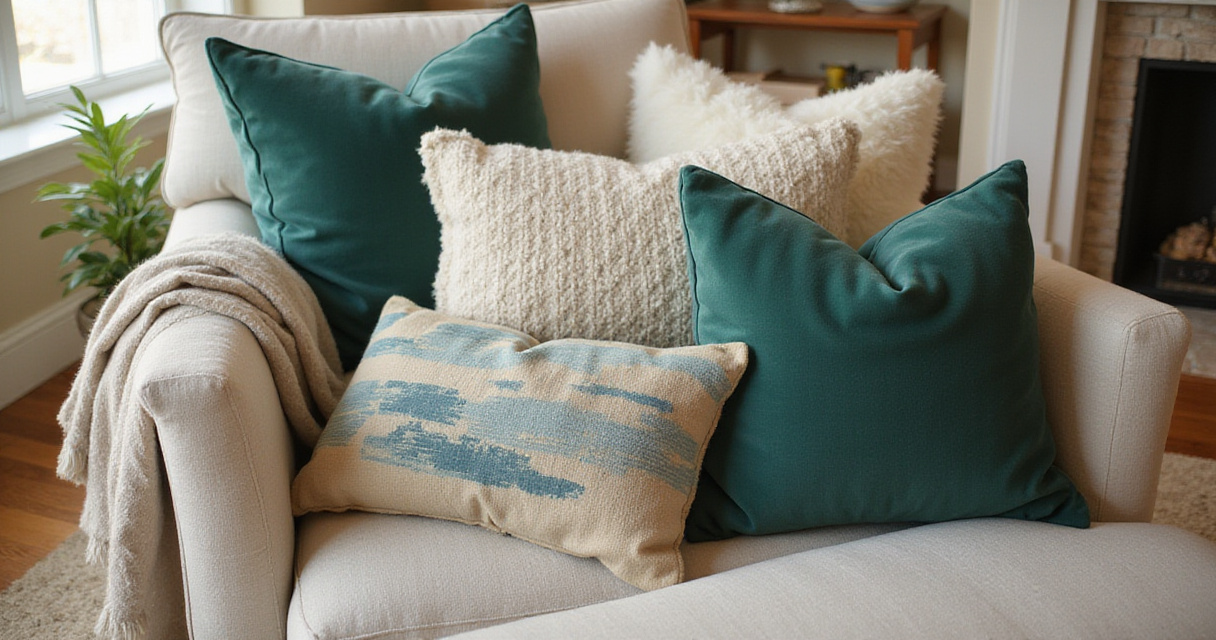
Transform your reading space with these 20 living room chair decor ideas from a library design expert. Learn how to create comfortable, stylish seating that reflects your personality and enhances your reading experience.
A good chair in a living room is more than just a place to sit. For a reader, it’s a destination. I’ve spent the better part of a decade designing library spaces, both public and private, and I’ve learned that the most successful reading spots aren’t accidents. They’re created with intention. A chair isn’t just furniture; it’s the heart of a small, personal world where you can lose yourself for hours.
But how do you turn a simple armchair into that kind of sanctuary? It’s about more than just finding a comfortable seat. It’s about building a small ecosystem around it that supports the act of reading. Whether you’re carving out a dedicated nook or just want to make a corner of your living room more inviting, the details matter. Let’s walk through twenty ways to give your favorite chair the attention it deserves.
We’re not just decorating; we’re creating a functional haven.
Pillows are the quickest way to make a chair say, “Come, sit here for a while.” But it’s easy to get this wrong. Too many pillows and you’re excavating a seat rather than sitting in it; too few and it feels stark. For most armchairs, I find one to three is the magic number. A single, great lumbar pillow offers crucial support for long reading stretches. Two gives you a chance to play with pattern and size. Three is pure luxury.
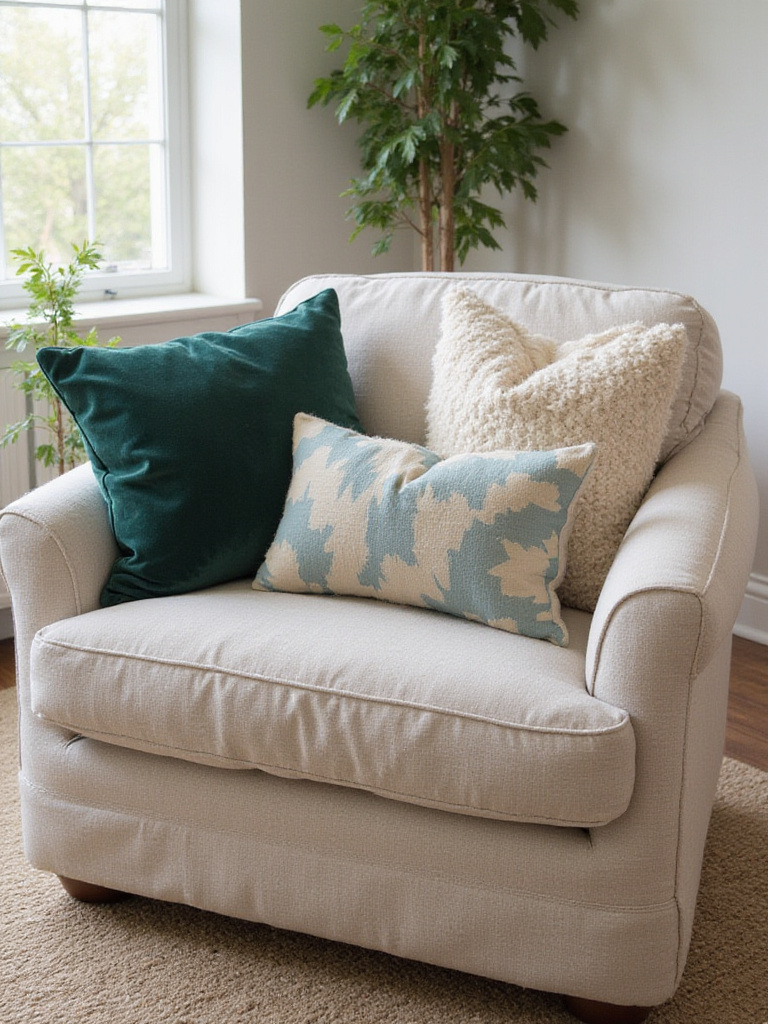
The real art is in the mix. Don’t just grab random pillows. Pull colors from a nearby rug or piece of art to create a cohesive look. Then, think about texture and scale. I love pairing a bold, large-scale geometric print with a finely-woven, solid-colored linen. The contrast is what brings it to life. Smooth velvet against a chunky knit, for example, is a combination that feels as good as it looks.
“A chair without a good pillow is like a book without a bookmark. Sure, it works, but you lose your place and the experience just isn’t as comfortable.”
From the softness of pillows, the natural next step is to introduce another textile that offers both practical warmth and a dose of style.
A throw blanket is non-negotiable in a reading nook. It performs two jobs at once: it adds visual texture and layering, and it provides actual, physical comfort. There’s nothing worse than getting perfectly settled into a chapter only to realize you’re cold and have to get up. A throw draped over the arm of a chair is an open invitation to stay put.
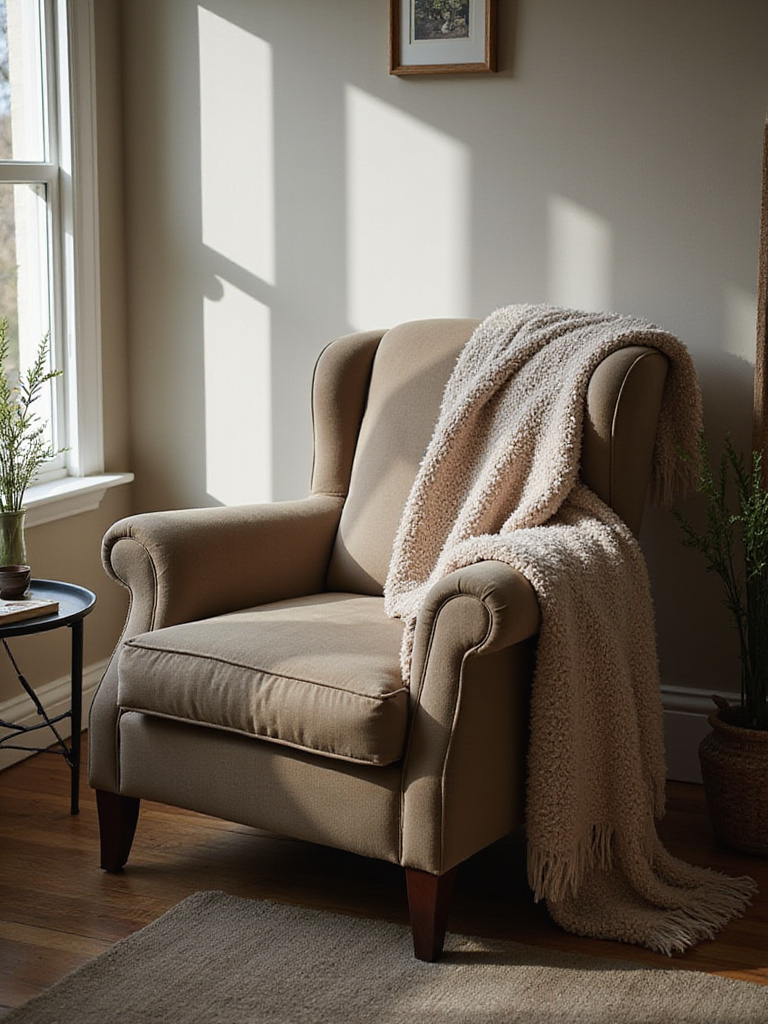
The material you choose really changes the whole experience. For a truly luxurious reading session, a soft cashmere or alpaca throw is incredible. But for a chair that gets a lot of daily use, a high-quality wool or even a soft acrylic blend can be more durable and practical. Here are a few ways I style them for my clients:
This simple piece of fabric transforms a chair from a piece of furniture into a personal retreat. Now, let’s talk about the foundation of that retreat—the chair itself.
In any room, a statement chair acts as an anchor. It doesn’t have to shout, but it should have a distinct personality that sets the tone. Instead of just blending in, it should draw your eye with its unique shape, a bold color, or an interesting texture. Frankly, it functions as a piece of usable art that tells a story about your style.
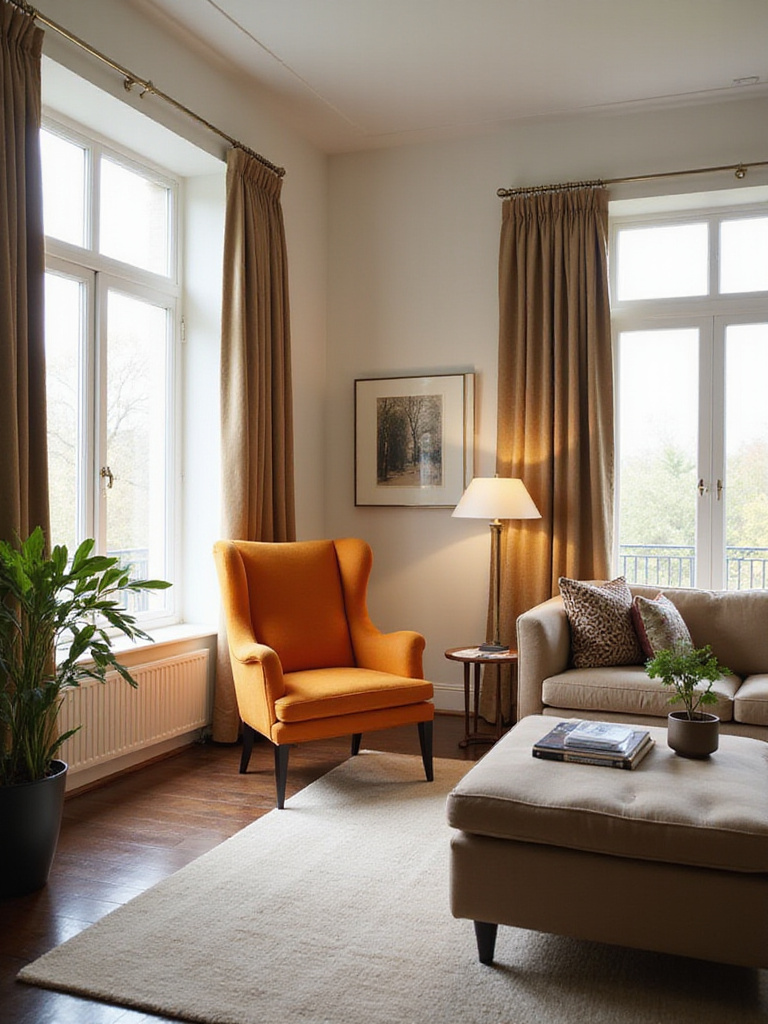
When you’re choosing one, think about its job. Is this a chair for marathon reading sessions? If so, comfort and support are paramount. A classic wingback is brilliant for this; the “wings” create a sense of enclosure and cut down on drafts, literally creating a cozy nook. Is it more of an accent piece? Then you can focus more on sculptural form. A mid-century modern lounge chair, for example, offers both ergonomic comfort and iconic style. The shape alone—think Eames Lounge Chair—makes a powerful statement.
The key is that it doesn’t have to match everything perfectly. Sometimes, the most interesting choice is one that provides a little contrast to the rest of your room.
Once you have the shape, the chair’s “voice” really comes from its covering. The fabric you choose is the next critical chapter in its story.
The upholstery is your chair’s skin. It’s the first thing you see and the first thing you feel. A rich, plush velvet suggests a bit of opulence, perfect for a room filled with classic literature. A crisp, natural linen feels more casual and breezy, great for a sun-filled spot. And a bold pattern? It can inject a dose of energy that completely revitalizes a space. The fabric sets the entire mood.
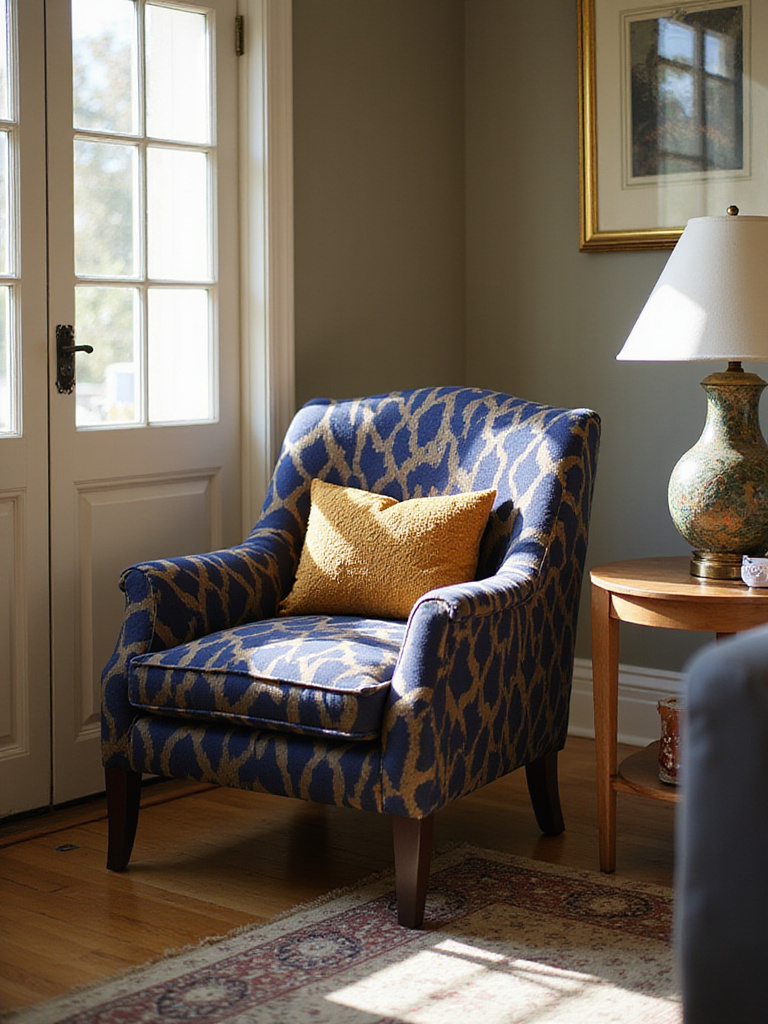
But this is where practical knowledge has to meet design. A reading chair is meant to be used, which means it needs to be durable. In the industry, we look at a fabric’s “rub count” to measure its resistance to abrasion. For a chair in your home, you want something with at least 15,000 double rubs. If it’s in a high-traffic family room, aim even higher. You also have to be honest with yourself about spills. I’ve had clients fall in love with beautiful raw silks, but then I have to ask: “What happens when you spill your morning coffee?” Performance fabrics have come a long way; you can now find options that are stain-resistant without feeling stiff or synthetic.
Finding that balance between a look you love and a material that suits your life is what makes for a successful, long-lasting choice.
With the perfect chair now selected and upholstered, we have to figure out the most important part: where does it actually live?
Where you put your chair is just as important as the chair itself. Placement defines how you use the room. It can create a natural conversation zone, ensure a smooth flow of traffic, or highlight a beautiful window. Bad placement, on the other hand, can make an entire room feel clumsy and unusable.

Start by looking for the room’s natural focal points. Is there a fireplace? A large window with a great view? A floor-to-ceiling bookshelf? These are natural anchors. Angle your reading chair towards one of them. Next, think about pathways. You need to be able to walk through the room without bumping into things. A good rule of thumb is to leave about 30-36 inches for a main walkway. And please, please consider the light. For a reader, having good natural light from a window is a huge plus. Placing a chair near one not only helps prevent eye strain but also connects you to the time of day.
One thing I always warn clients about is direct, harsh sunlight. While we love natural light, hours of direct sun every day can fade even the most durable upholstery over time. A spot with bright, indirect light is the sweet spot.
A well-placed chair feels intentional. Now let’s build on that by giving it a few essential companions.
A chair on its own is just a chair. But a chair paired with an ottoman or a side table? That’s a reading station. These pairings create a self-contained zone that supports you for hours. An ottoman is an ergonomic essential—propping your feet up helps with circulation and transforms a comfortable chair into a truly restful one. A side table is the mission control for your reading sessions. It holds your book, your glasses, a cup of tea, and a bookmark, all within easy reach. No more awkward leaning or getting up just as you get comfortable.
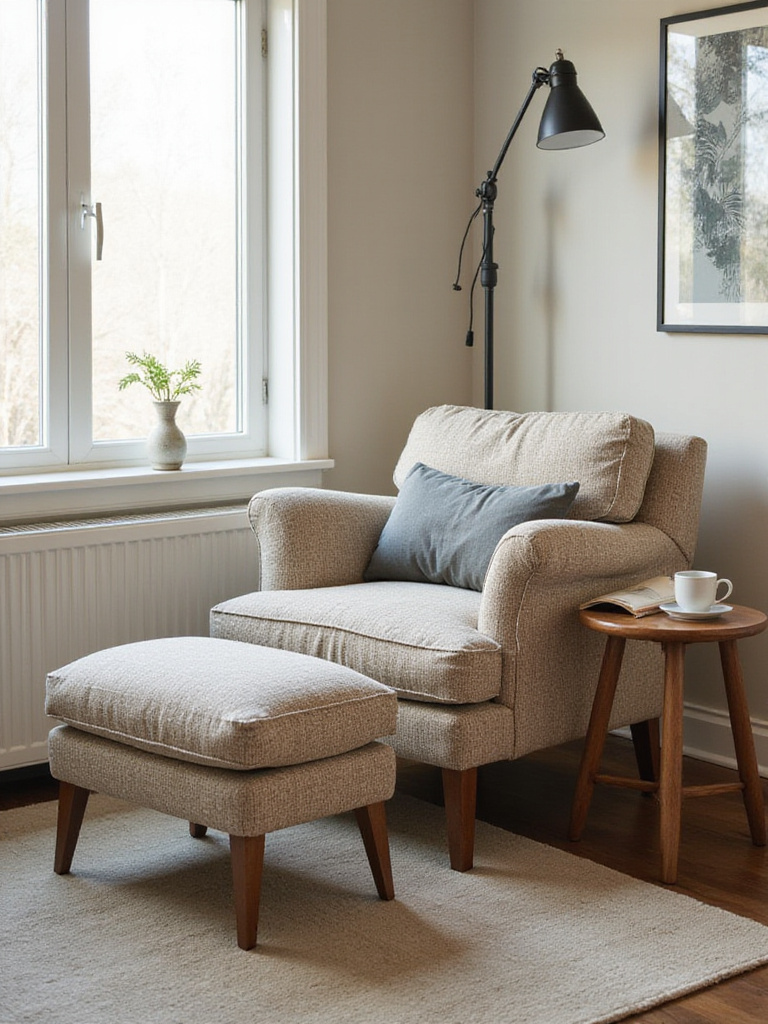
The key to a good pairing is proportion. An ottoman should be roughly the same height as the chair’s seat cushion, or just a little bit lower. A side table should be about the same height as the chair’s arm, making it easy to reach without straining. You don’t have to buy a matching set, either. In fact, it’s often more interesting if you don’t. A leather chair with a fabric ottoman, or a wooden chair with a metal side table, can add a nice layer of textural contrast.
I often suggest versatile pieces. Some ottomans have hidden storage inside—perfect for stashing away extra magazines or the book you just finished.
To really complete this little vignette and ground it in the room, we need to look down at the floor.
Placing a rug under or near your chair is like drawing a boundary for your reading nook. It visually separates that zone from the rest of the living room, making it feel more intentional and special. A floating chair can sometimes look a bit lost, but a rug anchors it and gives it a clear territory. It also adds a layer of color, pattern, and—most importantly—comfort and warmth underfoot. This is especially welcome on a cold morning when you’re curled up with a good story.
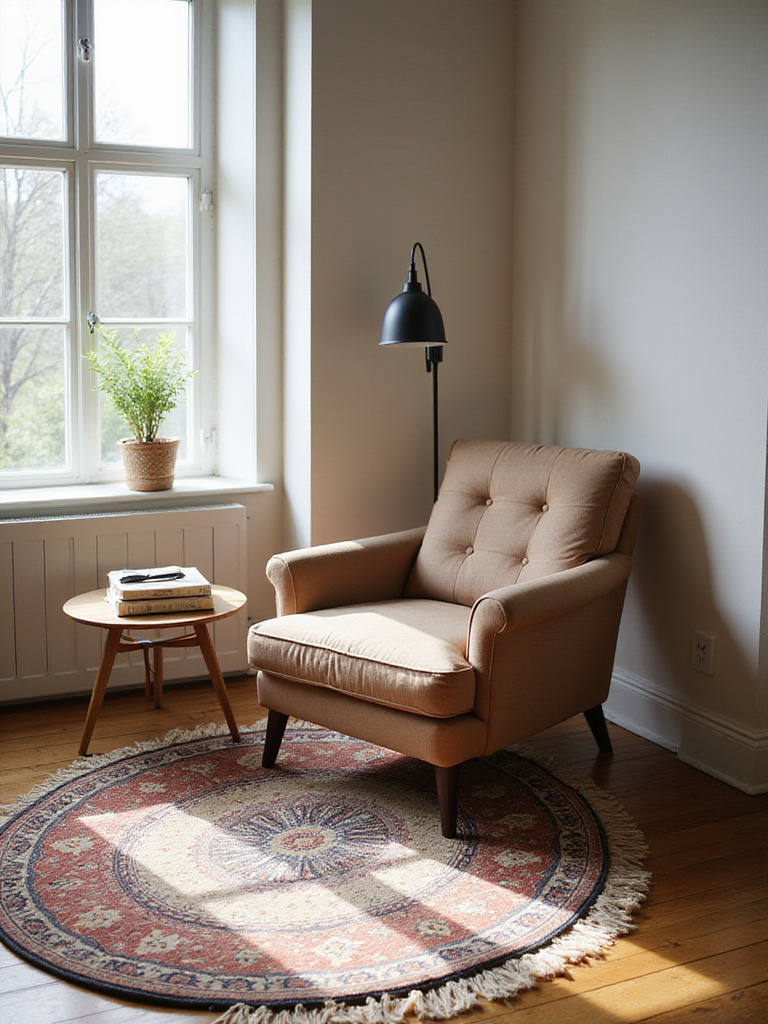
You don’t need a huge room-sized rug for this. Often, a smaller Area rug is all it takes. You can place it so that all four legs of the chair are on it, which creates a very defined space. Or, for a more casual feel, just have the front two legs of the chair resting on the edge of the rug. This works well to connect the chair to a larger seating area. For an accent chair, even a small 3’x5’ rug placed nearby can do the trick.
It’s a subtle change, but defining this space on the floor has a real psychological effect. It gives your reading ritual a physical home.
With the chair anchored, let’s make sure you can actually see the pages you’re trying to read.
This is a big one. Ambient light from a ceiling fixture is fine for general living, but it’s terrible for reading. To avoid eye strain and really focus, you need dedicated task lighting. A good reading lamp directs a focused pool of light exactly where you need it: on the page. Without it, even the world’s most comfortable chair isn’t a great reading chair.
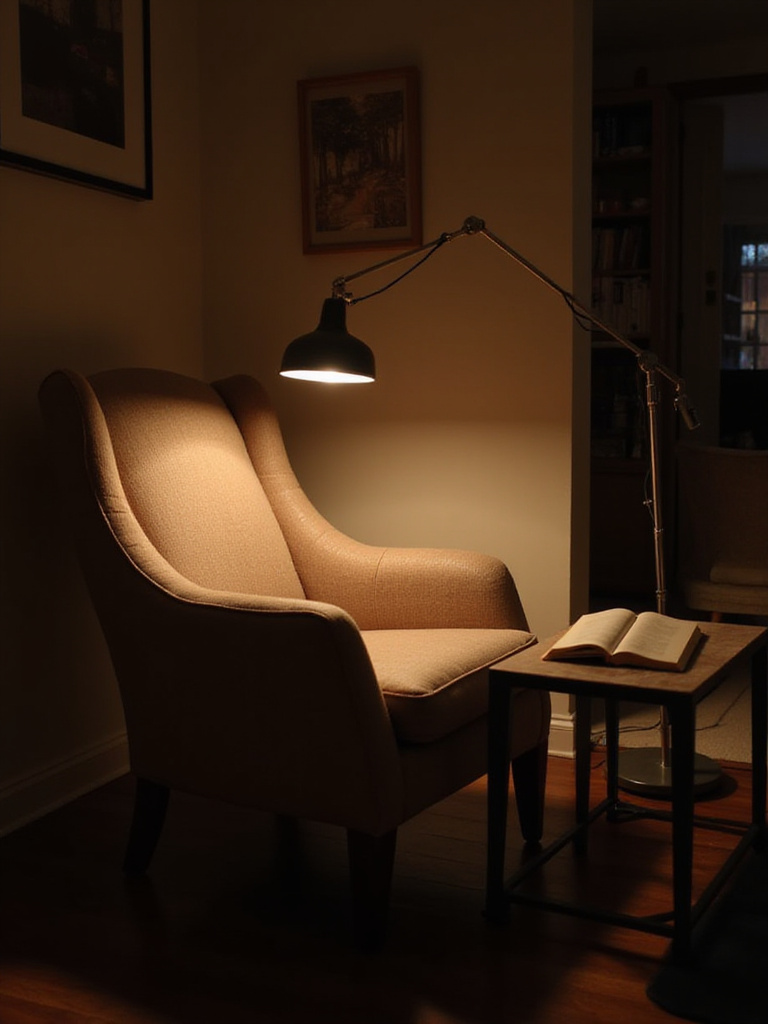
I always recommend something adjustable. A floor lamp with an articulated arm is perfect because you can swing it over your shoulder to get the angle just right. Wall-mounted swing-arm lamps are another fantastic option, especially for smaller spaces where you can’t spare the floor real estate. The ideal placement is slightly behind you and to one side, so the light falls on the book without casting a shadow from your head or creating a harsh glare on the page.
“The right reading lamp is a spotlight for a one-person show. It quiets the rest of the room and creates a world that contains only you and your book.”
And a quick technical tip: look for a bulb with a color temperature around 3000K. It gives a clean, warm-white light that’s ideal for reading, not too yellow and not too starkly blue.
Now that we have light, let’s think about what’s framing your reading retreat from behind.
The wall behind your chair is like the set dressing for a scene. An empty wall can make your carefully chosen chair feel a bit disconnected, like it’s floating in space. Styling that wall creates a finished, cohesive vignette that makes the whole corner feel deliberate and thoughtfully designed.
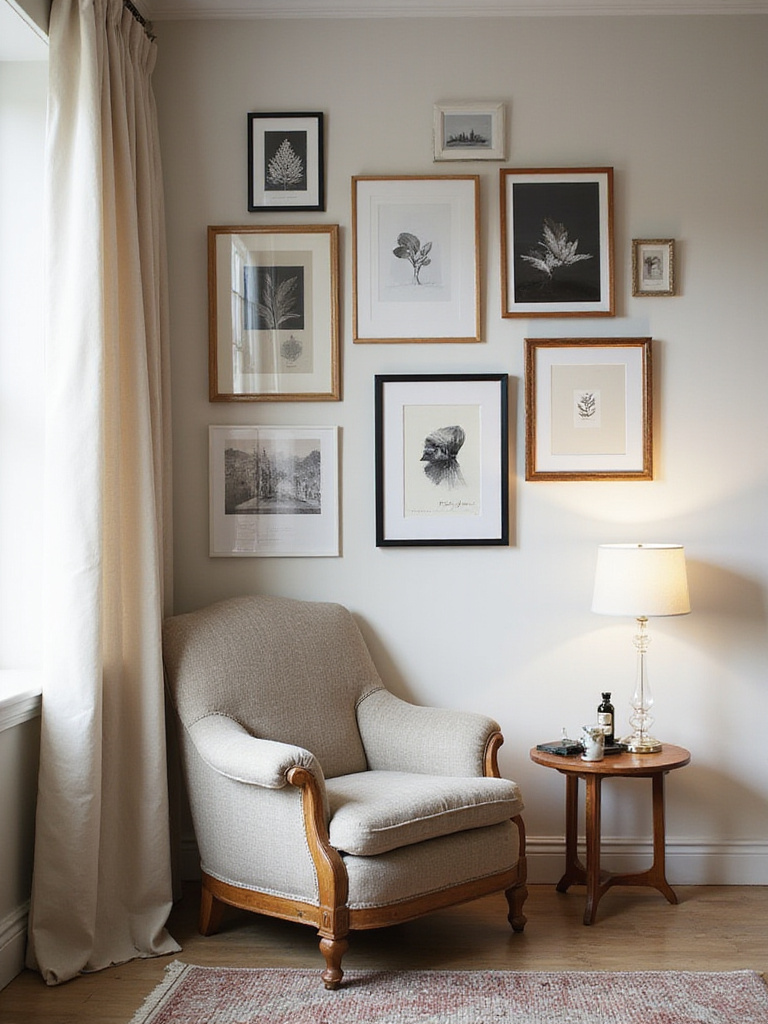
You don’t have to do much. A single, large piece of art can work beautifully. A good rule is to choose a piece that’s about two-thirds the width of the chair itself. Another one of my favorite approaches for a reading nook is to install a few floating shelves. You can style them with a handful of your most beautiful books, a small plant, and a personal object or two. It reinforces the purpose of the space while adding dimension and personality. A gallery wall of smaller prints or photos can also work, creating a more eclectic, collected feel.
The key is to connect the wall decor to the chair, either through color, style, or theme. This simple step elevates the entire arrangement from just furniture to a designed space.
For those who crave change, or just have a chair that’s seen better days, our next idea is a game-changer.
I know what you might be thinking: saggy, wrinkled, ill-fitting sheets. But modern slipcovers are a different beast entirely. They offer incredible versatility, letting you completely change the look of your reading chair with the seasons, your mood, or even your current literary obsession. And on a practical level, for a true book lover, they’re a lifesaver. Coffee spills, pen marks, snack crumbs—a washable slipcover means you don’t have to worry about living in your reading chair.
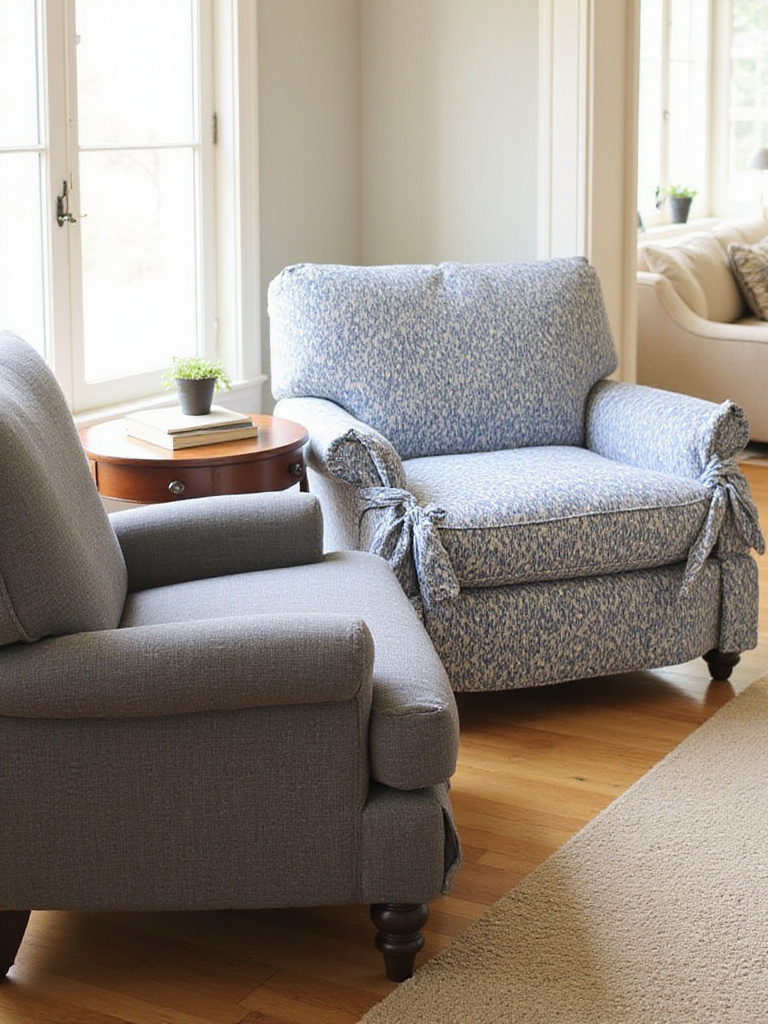
Today you can find everything from custom-fit slipcovers tailored to a specific chair model to high-quality stretch versions that hug curves for a surprisingly clean look. The fabric choices are just as varied. You can have a durable, light-colored cotton twill for summer reading in the sun, then swap it for a deep, cozy velvet in the winter.
It’s the ultimate way to get a fresh look without buying new furniture. A great slipcover can give a tired, old, but beloved and comfortable chair a whole new life.
While a cover handles the big picture, a smaller, more targeted addition can make all the difference for long-term comfort.
A lumbar pillow isn’t just another decorative cushion; it’s an ergonomic tool. For anyone who reads for more than twenty minutes at a time, it’s a necessity. It’s designed specifically to support your lower back, maintaining the natural curve of your spine and preventing the aches and fidgeting that can pull you out of a good story.
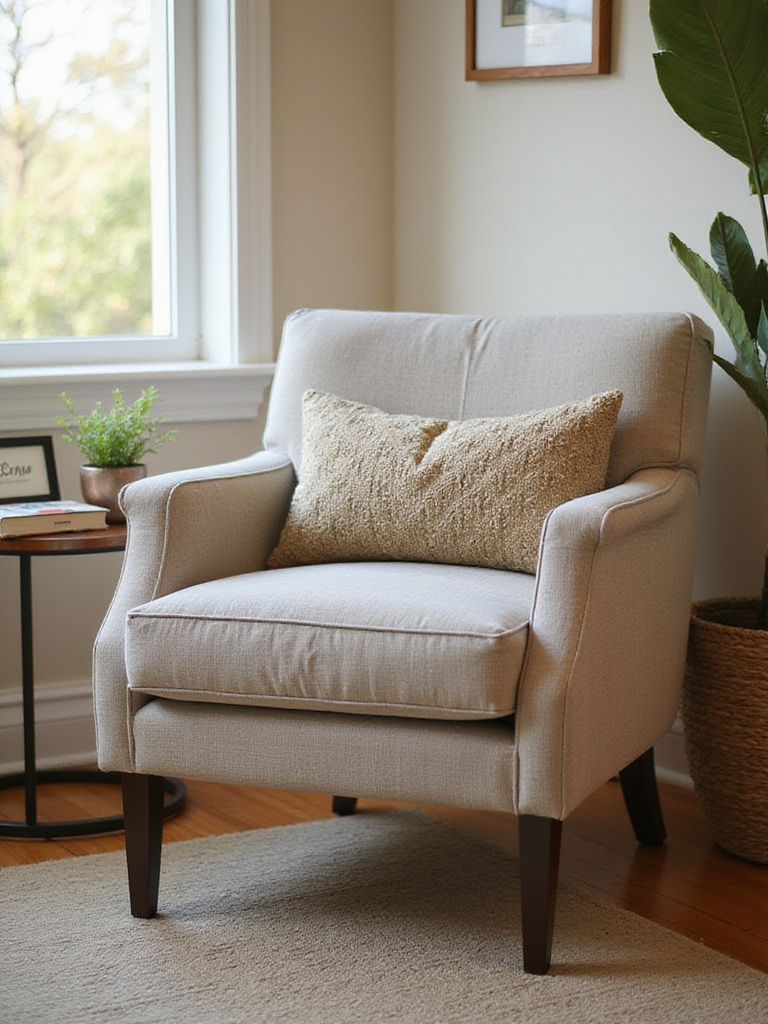
From a design standpoint, they’re fantastic because their small size provides a concentrated pop of style. You can use a lumbar pillow to introduce a daring pattern or a rich texture that might be overwhelming on a larger scale. A beautiful one in a contrasting color or material can be the perfect finishing touch on a chair. I often suggest a firm foam core for the best support, covered in a fabric you love—maybe a soft leather, a textured bouclé, or a print that ties into your room’s decor.
It should be wide enough to support your lower back but not so big that it pushes you forward in the seat—roughly half to two-thirds the width of the chair back is a good target. It’s a small detail that provides a massive return in comfort.
To round out your comfort zone, let’s add a couple more versatile accessories.
Trays and poufs are the ultimate supporting cast for your reading nook. A simple tray—wood, metal, lacquer—can be placed on a nearby ottoman or pouf to create an instant, stable surface for your tea, your glasses, or a small snack. It’s a simple solution that prevents spills and keeps your essentials organized and within arm’s reach.
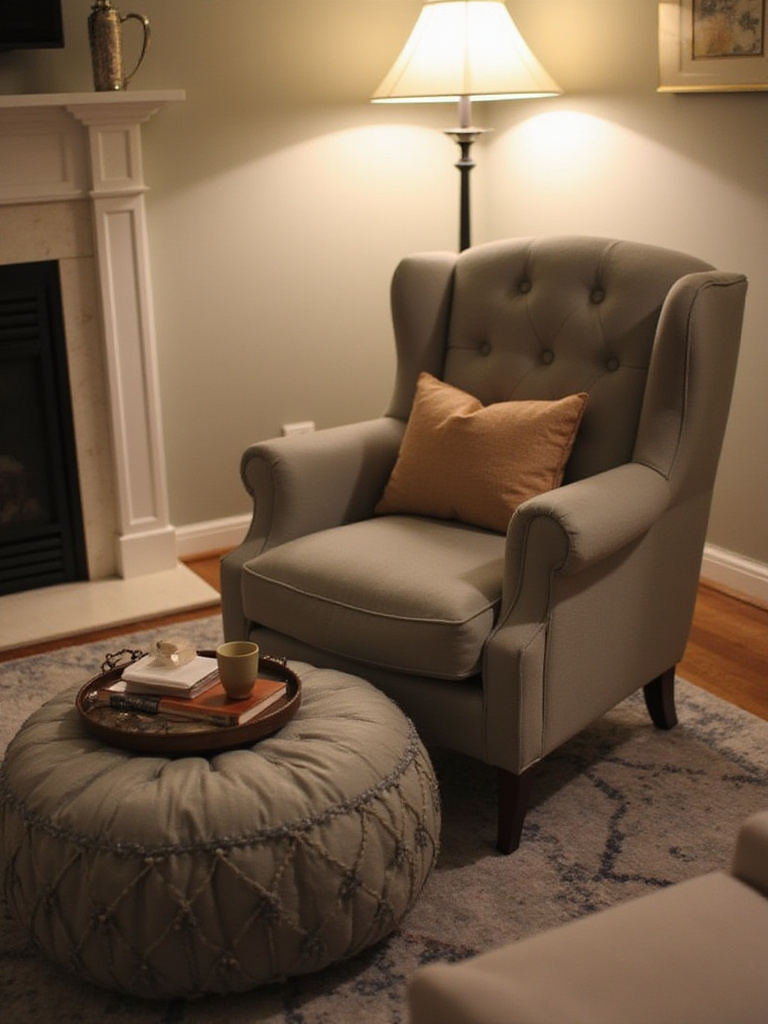
Poufs are the utility players of the living room. They are wonderfully versatile. One minute it’s a footrest for a long reading session, the next it’s an impromptu side table (with a tray on top), and the next it’s extra seating when a friend drops by to discuss your latest book club pick. They are softer and more casual than a traditional ottoman, and their light weight makes them easy to move around as needed.
You can coordinate them with your chair or choose a contrasting material or pattern to add another layer of interest. A chunky knit pouf adds cozy texture, while a leather one feels a bit more structured and sophisticated.
When you’re trying to coordinate all these different elements, a surprisingly effective unifier can be found in nature.
Placing a plant near your reading chair does more than just fill a space. It introduces a living, breathing element that has a genuinely calming effect. Plants soften the hard lines of furniture and walls, add natural texture, and create a sense of tranquility that is perfectly suited to the immersive act of reading. They also literally improve the air quality, creating a healthier little microclimate for you to relax in. A plant can help define your reading nook, transforming it into a small, green retreat.
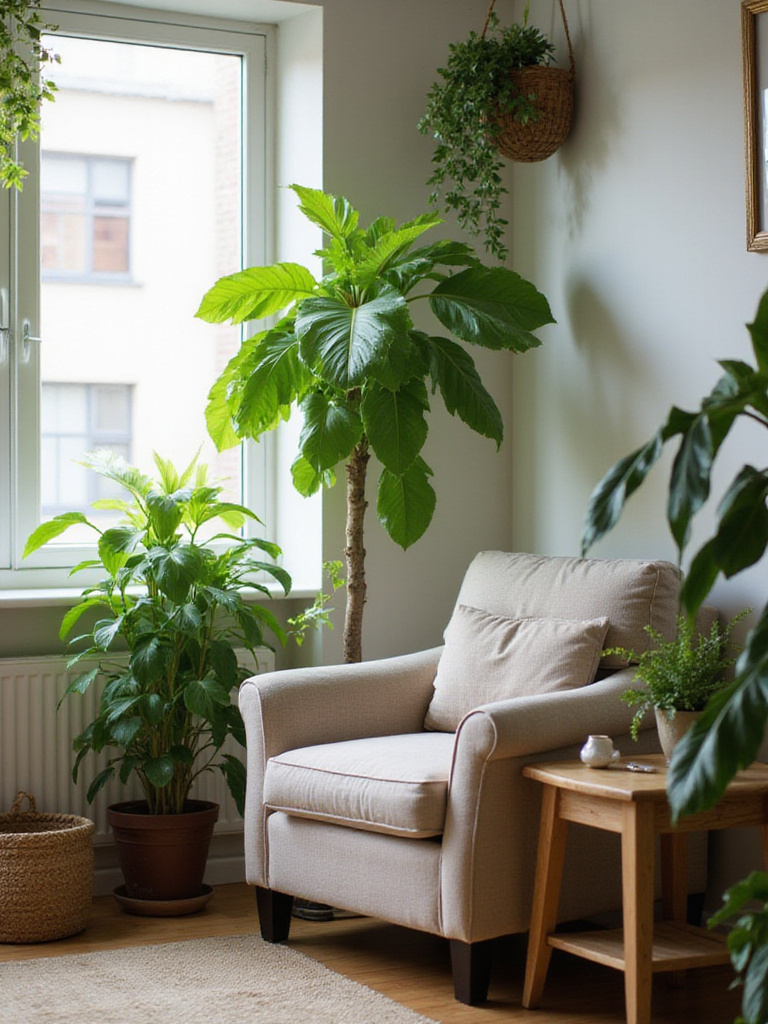
When you’re choosing one, be realistic about the light in that spot. If your chair is in a dim corner, a snake plant or a pothos will be happy there. If it’s next to a bright window, you have more options. Think about scale, too. A tall fiddle leaf fig or a monstera can make a dramatic statement behind a chair. A smaller plant on your side table adds a subtle touch of life. Just be sure to check if a plant is toxic if you have curious pets or children.
A little bit of green makes any space feel more alive and peaceful—the perfect companion for getting lost in a book.
Now, let’s look at an often-overlooked detail of the chair itself that can make a big design impact.
Most people don’t think about chair legs, but they contribute so much to the chair’s overall style and how it feels in a room. They’re not just structural; they’re a key design element. Tapered wooden legs signal mid-century style, ornately carved legs feel traditional, and sleek metal legs are distinctly modern. Highlighting them adds a layer of design sophistication.
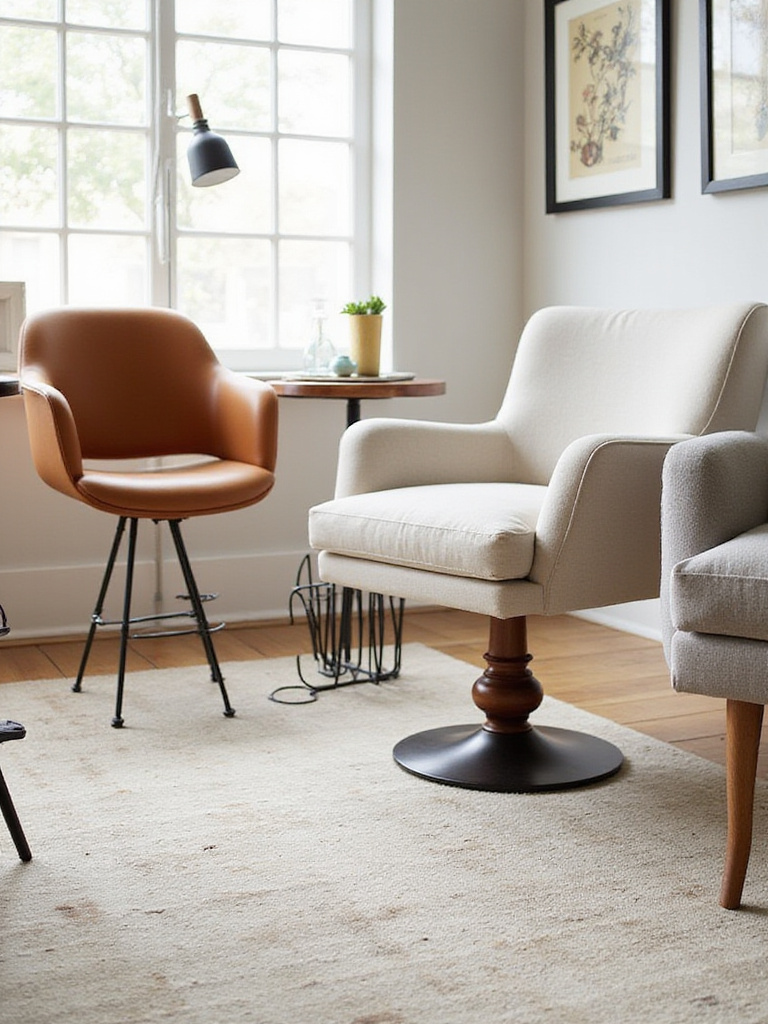
More importantly, the legs have a huge impact on the perception of space. This is a big one. Chairs with visible, elevated legs create open space underneath, which makes a room feel larger and airier. This is an invaluable trick for smaller living rooms or compact reading corners. A chair with a skirt or a solid base that goes all the way to the floor has more visual weight and feels more grounded and substantial. Neither is better—it just depends on the effect you want to create.
Don’t be afraid to let a beautiful set of legs be part of your design. Sometimes, simply choosing a rug that doesn’t hide them can make all the difference.
Staying on the lower half of the chair, let’s revisit the idea of putting your feet up with a bit more detail.
We’ve touched on poufs, but it’s worth clarifying the difference between them and a more traditional footstool. It really comes down to structure and formality. A footstool is typically a more structured piece, often with a wood frame and legs, and a firm, upholstered top. It offers solid support and has a more formal, traditional feel. A pouf, by contrast, is a soft, often legless cushion that sits directly on the floor. It’s casual, relaxed, and more versatile.
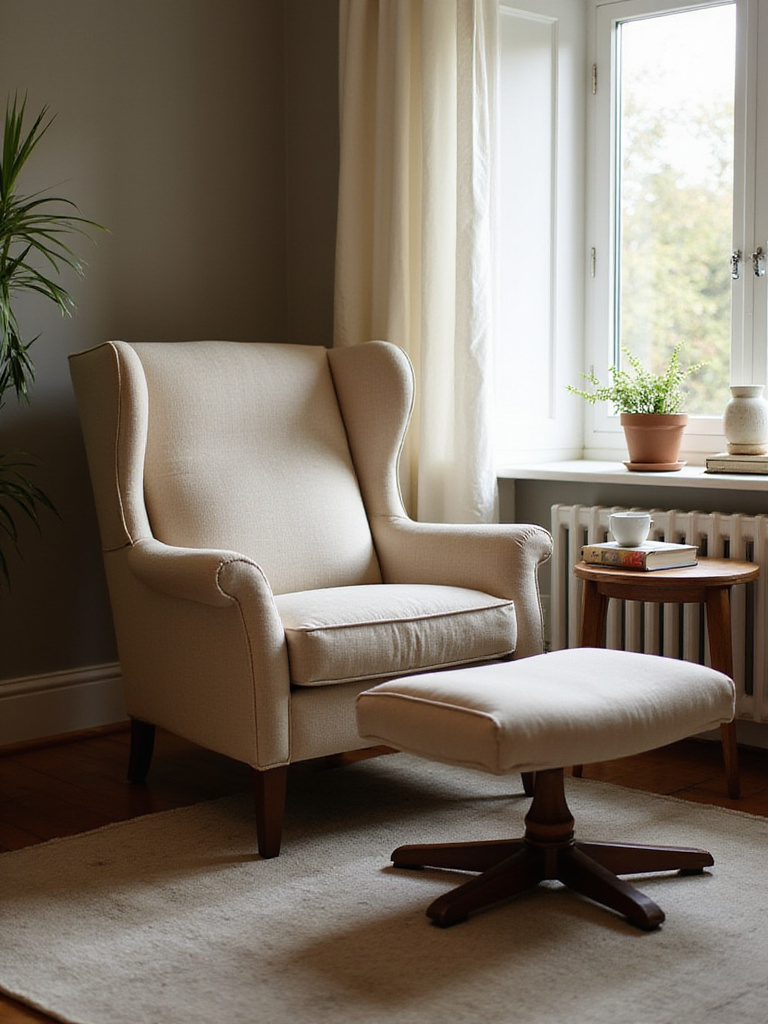
Which one is right for you? It depends on your chair and your style. A classic, stately leather reading chair pairs beautifully with a matching structured footstool. A more modern or bohemian-style chair might feel more at home with a casual, textured pouf. In terms of comfort, the height is key. You want your feet to be able to rest comfortably, with your knees equal to or slightly lower than your hips. So, aim for a footstool or pouf that’s roughly the same height as your chair’s seat.
Think of it this way: a footstool is a dedicated partner. A pouf is a flexible friend.
What if the problem isn’t your feet, but the seat itself?
Let’s be honest. Sometimes a chair looks incredible but is just not that comfortable for a long sit. Or maybe you have a beloved chair that’s started to sag over the years. This is where a separate seat cushion can save the day. Functionally, it can dramatically improve the comfort level, adding the padding you need to read for hours. Aesthetically, it’s another opportunity to add color, pattern, and texture, refreshing an old chair without the expense of a full reupholstery job.
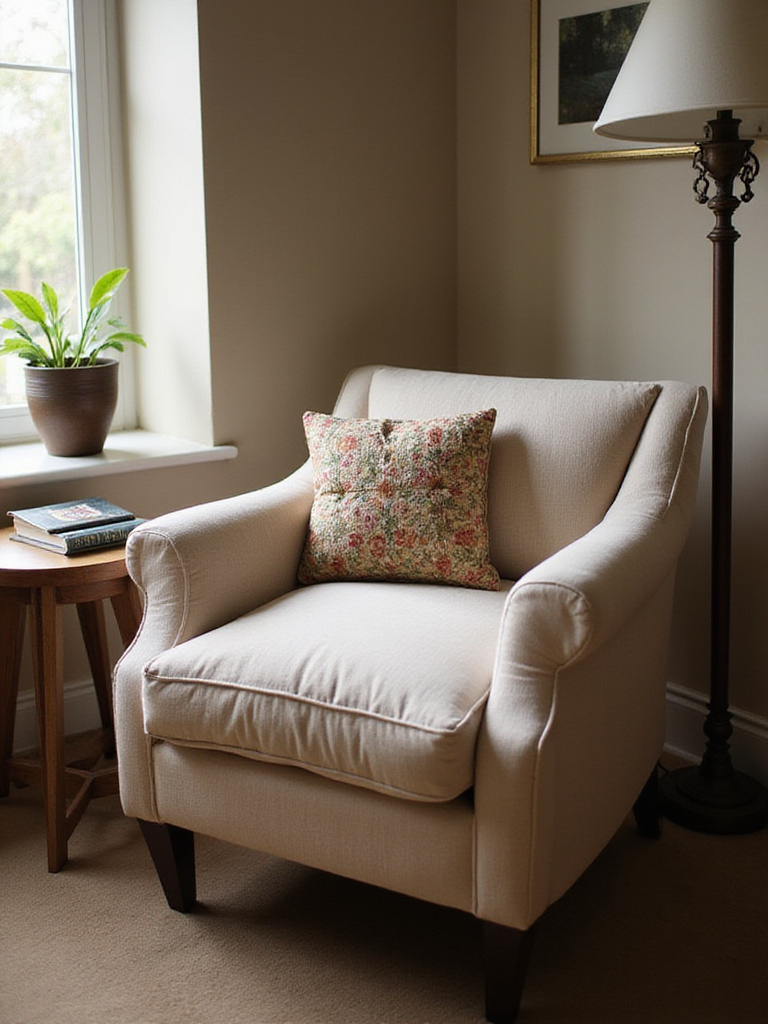
When you’re choosing one, make sure you get the size and shape right. Measure your seat and find a cushion that fits snugly without hanging over the edges. A firm foam will offer the best support for good posture, while a down or feather-filled cushion will feel more plush and luxurious (though it will need occasional fluffing).
I love using a seat cushion to tie a nook together. You can choose a fabric that picks up a color from your throw blanket or a pattern from your lumbar pillow, creating a layered, intentional design.
Once you master adding these layers to a single chair, you can get even more adventurous.
There’s no rule that says all your chairs have to be from the same set. In fact, a room is almost always more interesting when they’re not. Mixing different chair styles creates a curated, collected-over-time feeling that is much more personal than a perfectly matched suite from a catalog. It lets you pair a sleek modern reading chair with a sentimental antique you inherited, for example.
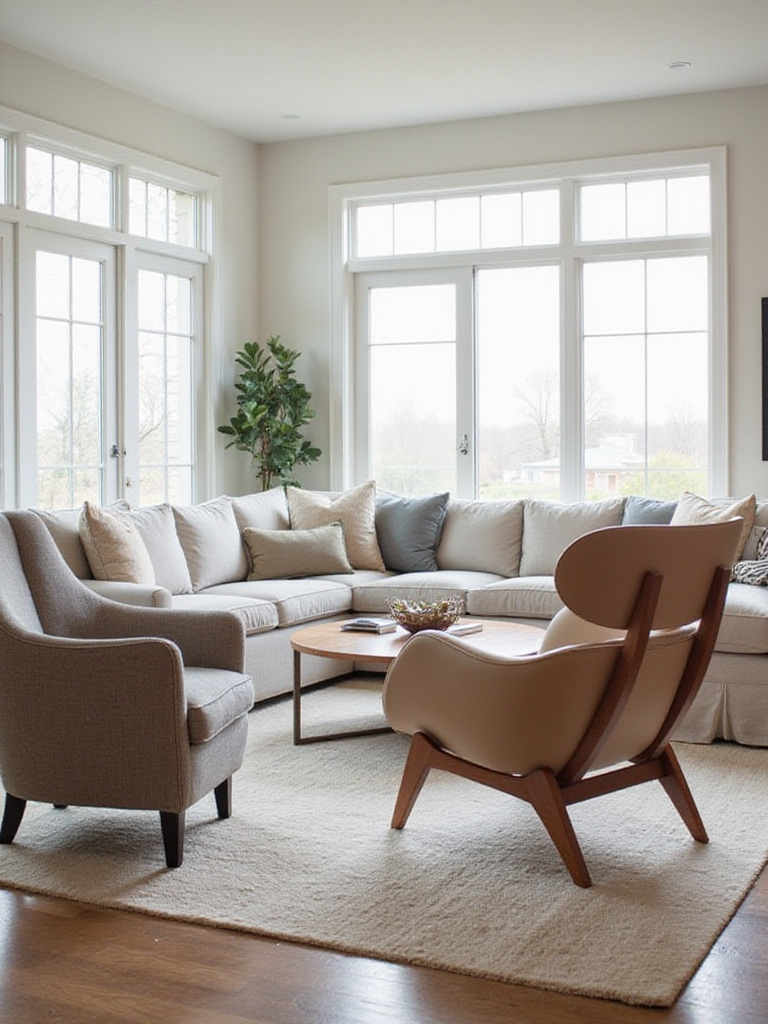
The trick to making it work is to find a common thread that ties them together. It doesn’t have to be obvious.
This approach lets you build a room that truly reflects your taste and your story, piece by piece.
Another way to inject personality is by being bold with your fabric choices.
Patterned fabric is one of the most powerful tools in a designer’s kit. A bold pattern can turn a simple, inexpensive chair into the star of the room. It can inject energy, personality, and a clear design direction. A subtle pattern, on the other hand, can add texture and depth without overwhelming the eye, saving a space from feeling flat or one-dimensional. For a reading chair, pattern can be a wonderful way to express your personality.
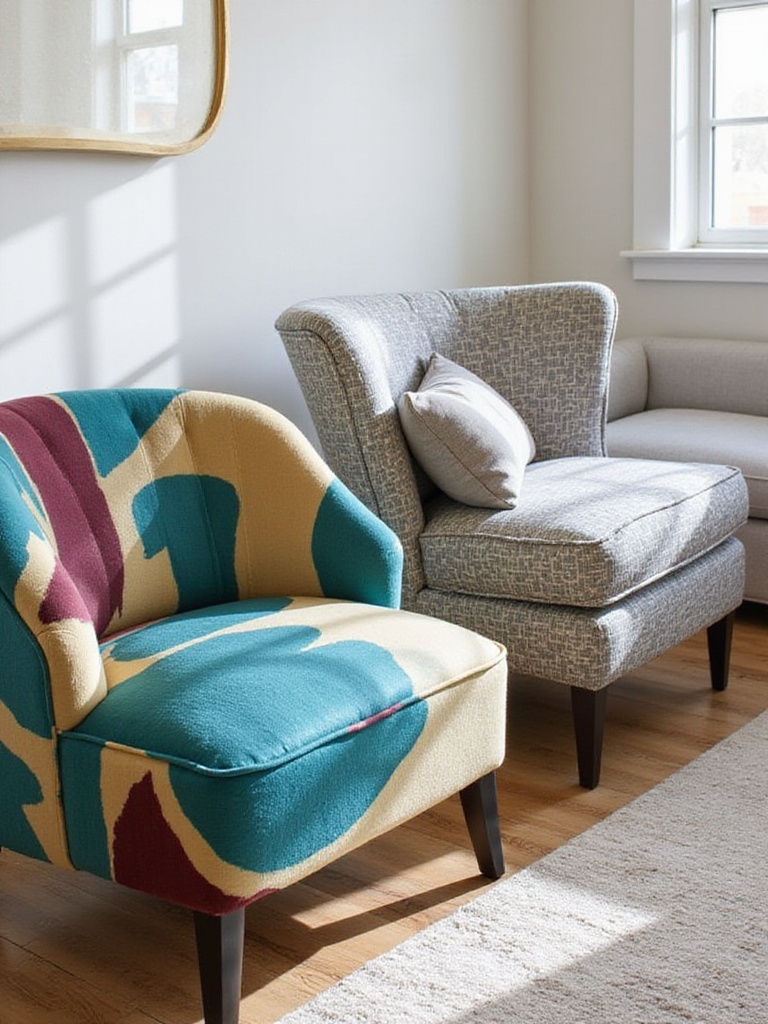
If you’re nervous about mixing patterns, here’s a simple rule of thumb that designers use all the time: vary the scale. Pair a large-scale pattern (like a big floral or a wide stripe) on your main chair with a medium-scale pattern (like a geometric) on a pillow and a small-scale pattern (like a tight herringbone or a pinstripe) on an ottoman or another accent. As long as they share a common color palette, the mix will feel exciting, not chaotic.
“A pattern is the prose style of a fabric. Some are poetic and subtle, others are direct and punchy. The one you choose determines the tone of the whole room.”
Don’t be afraid to let your chair’s fabric tell a story.
No matter the style or pattern, one final, crucial element can make or break the entire setup.
This is a fundamental that people often get wrong. A chair’s scale must be appropriate for the room’s dimensions. It’s like wearing a suit that’s two sizes too big or too small—it just looks off. In a small room, a massive, overstuffed armchair can feel like a bully, hogging all the space and making the room feel cramped. In a huge, high-ceilinged room, a tiny, delicate slipper chair can look lost and insignificant.
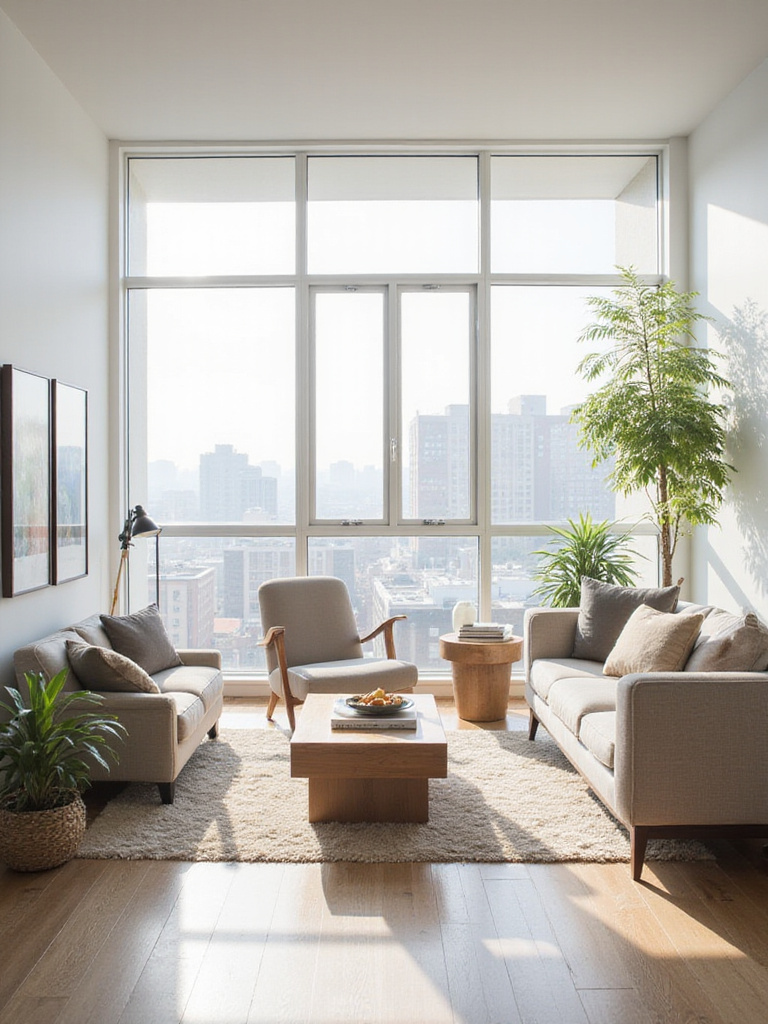
How do you get it right? Look at the other furniture in the room. Your reading chair should feel like it’s in proportion to your sofa and other major pieces. Also, think about that visual weight we talked about. In a small space, a chair with a lighter profile—slim arms, visible legs—is almost always a better choice than a heavy, bulky one, even if their actual footprints are similar.
Here’s a practical tip: before you buy, use painter’s tape to mark the chair’s dimensions on the floor. This lets you physically see how much space it will take up and how it will affect your traffic patterns.
Finally, after all the practicalities are sorted, we get to the best part.
This is what turns a well-designed space into your space. It’s the final layer that reflects your life as a reader. It transforms the chair from a generic piece of furniture into your chair. These touches tell a story and make the space feel authentic and lived-in, not like a sterile showroom.
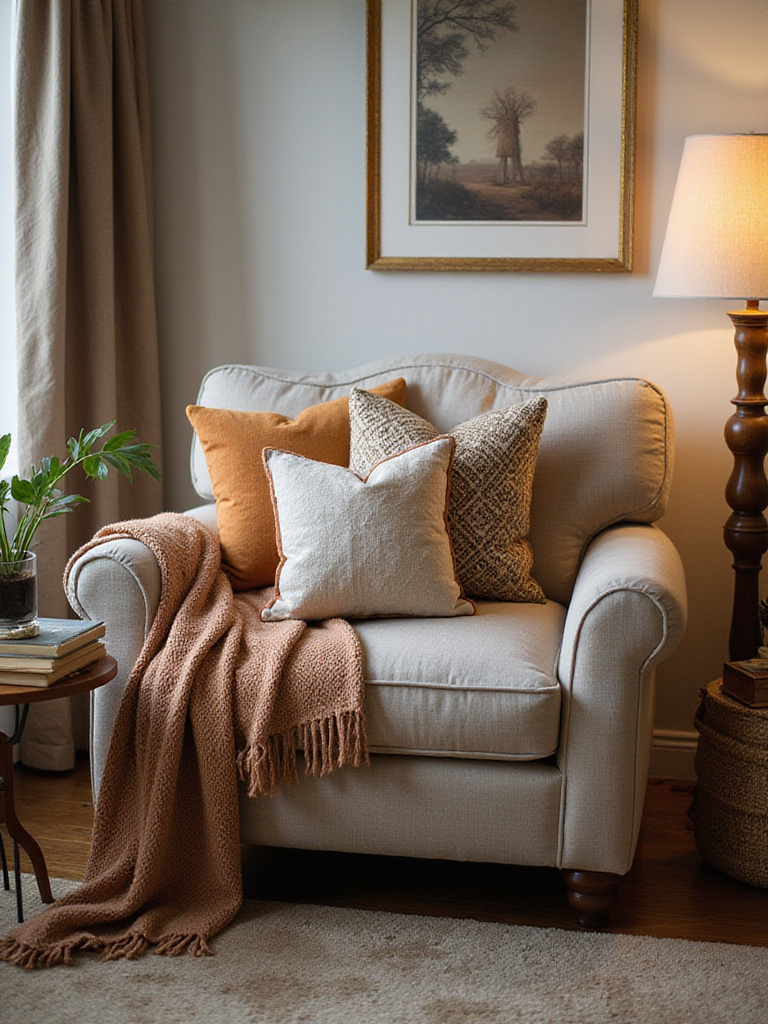
What does this look like? It could be draping a beautiful scarf you bought on a trip over the back instead of a standard throw. It could be keeping a small, unique bowl on the side table to hold your favorite bookmarks. Maybe it’s a framed photo of a place that inspires you or a coaster made by a local artist. It’s about surrounding yourself with small things that have meaning and enhance the ritual of reading for you.
Your reading chair should be a sanctuary, and these personal elements are what make it feel like home. They’re a quiet statement that this space is reserved for you and your stories.
Decorating a living room chair is so much more than just making it look nice. It’s an act of creating a personal haven. By thinking through everything from the chair’s style and placement to the crucial support of lighting, pillows, and side tables, you are building a space that invites you to do one thing: stay awhile and read. Each of these ideas is a tool you can use to craft a corner that is perfectly suited to you.
Remember that the goal is to create a space that reflects your unique relationship with books. It should be a balance of form and function, of beauty and genuine comfort. The chair where you spend hours exploring other worlds becomes a significant character in the story of your own home. By giving it this kind of thoughtful attention, you’re not just creating an attractive seating arrangement—you’re investing in your own peace and enjoyment for years to come.